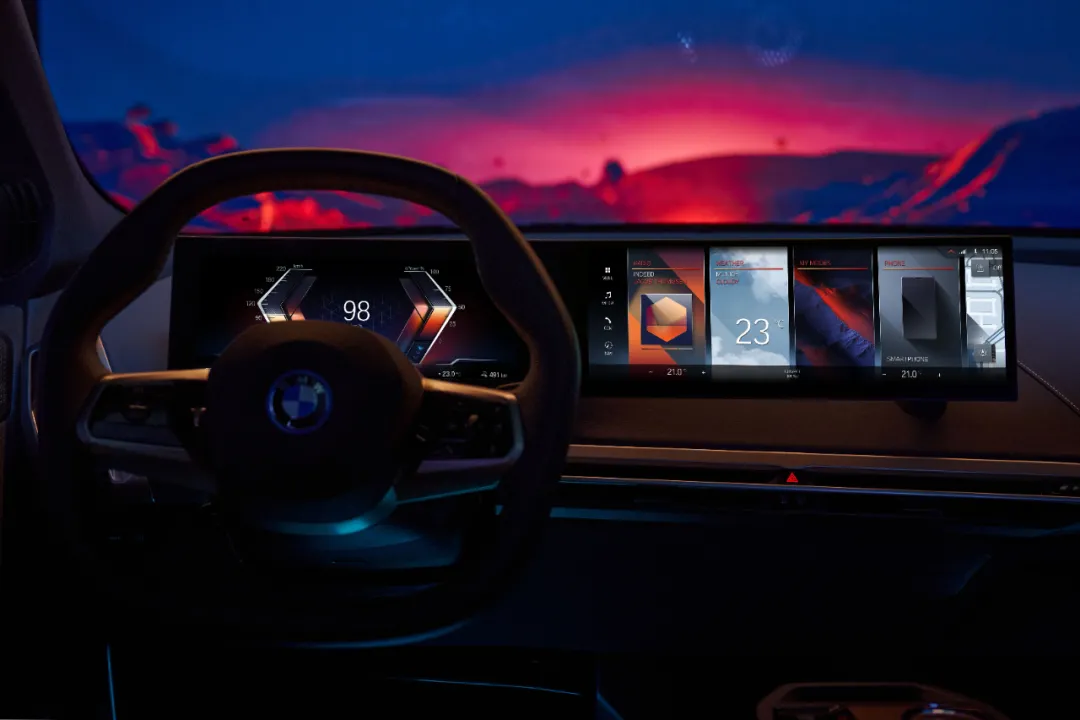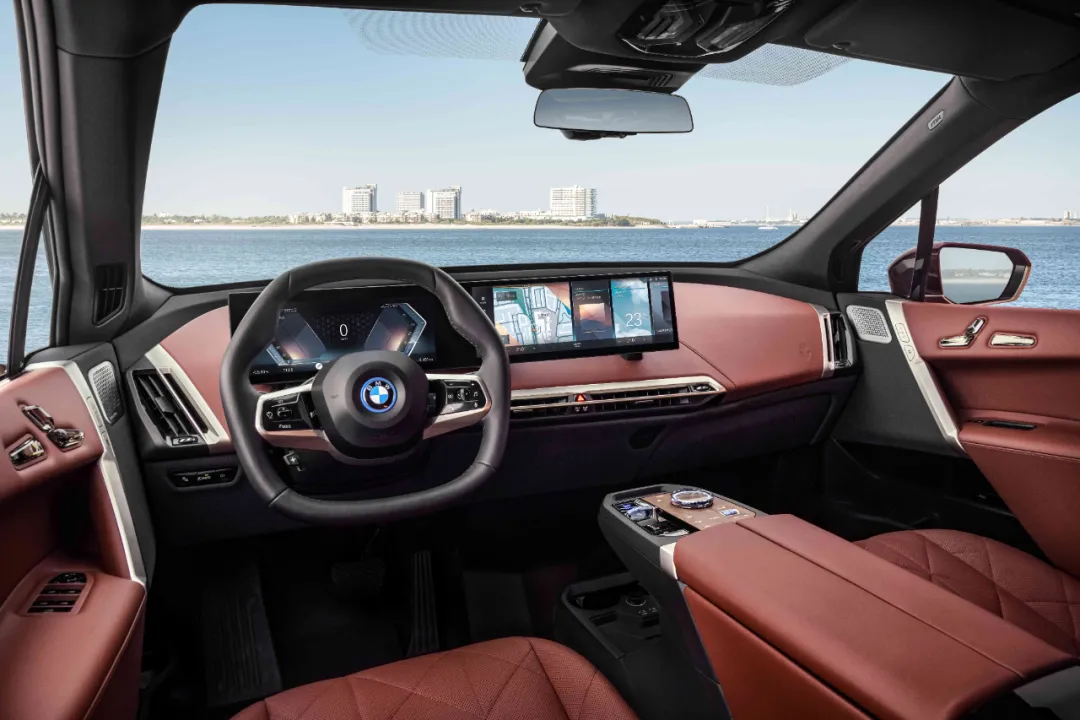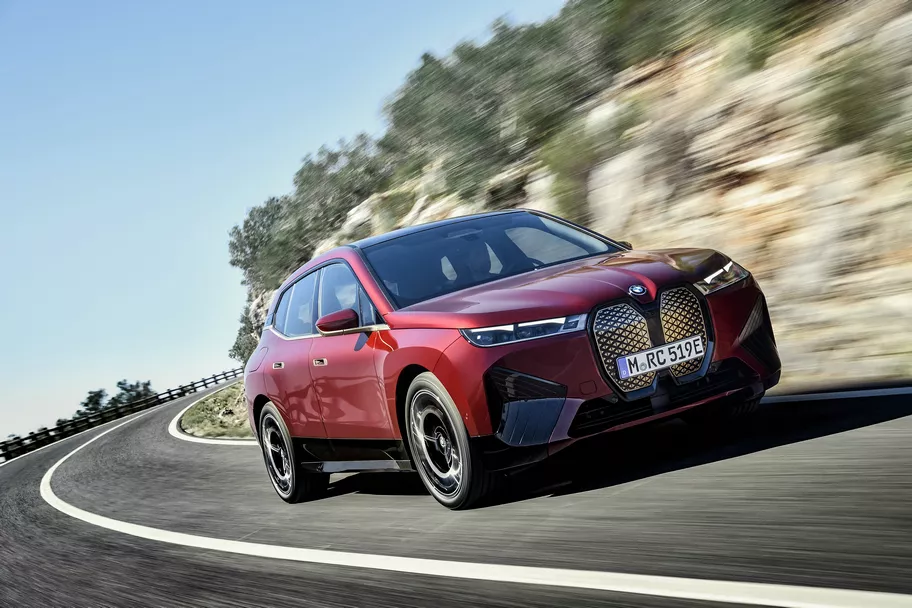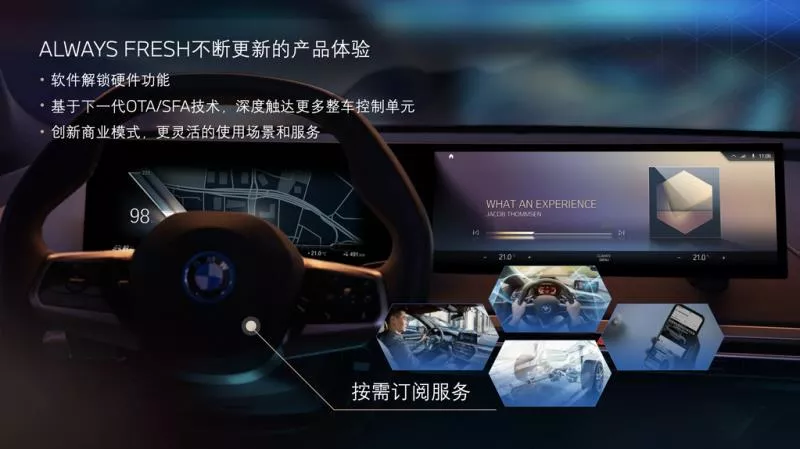Author: Qiu Kaijun, Xiao Ying
In the era of intelligent network connectivity, all automotive enterprises seem to have been pulled to the starting line, and even luxury brands are unable to rely on past glories to endorse their intelligence.
Is this really the case? Did luxury brands just begin to explore intelligence and network connectivity together with new automakers from today?
A week ago, BMW Group shared its digital-forward strategy and digital user experience around innovation BMW iX and new BMW iDrive.
After watching that live broadcast, we seem to have found some answers.
From the BMW E38 with the first generation BMW iDrive in 2001 to the innovative BMW iX that debuted in April this year, BMW’s human-machine interaction system has a development history of 20 years.
The new BMW iDrive is BMW’s latest human-machine interaction system, and is also considered to be the new beginning of BMW in the era of intelligent electric vehicles. Through the analysis of the design philosophy and functional presentation of the car system of this new generation, we found that there are some things that BMW has adhered to in its value concept.
Even when expanding new functions and experiences for intelligent network connectivity, these concepts are still identifiable, which may be BMW’s insistence as a luxury brand.

Driver-centric Control Experience
When it comes to BMW’s advantages, many people’s first reaction is driving performance. This is actually the core value of the BMW brand, which emphasizes “driving pleasure and a chic lifestyle”.
As the brand value guide, BMW has been tirelessly improving the handling performance of cars for decades, and the entire research and development and technological innovation strategies are clearly focused on how to improve driving pleasure.
In the creation of the intelligent cockpit, BMW also adopted an information presentation design centered on the driver, which is intuitively reflected in the innovative BMW iX.
Entering the cockpit, the most eye-catching is the integrated floating curved surface screen. Compared with BMW operating system 7.0, this screen is not only better designed, but its greatest value lies in satisfying the driver’s visual comfort – the curved screen is driver-centric.
The design of the curved screen makes all areas displayed on the screen as close as possible to the driver’s eyes, avoiding the difficulty of driver information acquisition and the problem of distracting driving attention.

Underneath the hardware, the concept of being centered on the driver also runs through UI interface design and UX interaction logic.Based on a brand new interface layout and interactive concept, the innovative BMW iX cockpit display system meticulously integrates three screens – the head-up display (HUD), the instrument cluster and the central display screen – to present information in a hierarchical manner on the screen that is most suitable for the driver, thereby allowing for rapid and convenient access to essential information and enhancing safety.
For example, as a BMW iX approaches an intersection, the HUD system will display the next set of actions, and the instrument cluster will show more details about the road, including navigation information for the three leading directions, while the infotainment display screen will display an overview of the entire journey, including traffic conditions, mileage, merchant information, and parking recommendations.
According to BMW engineers, the purpose of this design approach is to minimize cognitive effort by reducing the density of information to help drivers quickly assess traffic conditions and control their driving experience.
In summary, all of the BMW cockpit designs are intended to convey a concept to drivers: “You are in control.”
Reliability! Reliability! Reliability!
Safety, reliability, and consistency have always been integral components of the BMW brand. In software, BMW continues to uphold its uncompromising commitment to reliability investment.
BMW engineers cited several examples. For the development of human-computer interaction systems, the software development process is similar to hardware development, and model experimentation should begin 18 to 36 months before mass production, or even earlier.
To meet the verification needs of product development, BMW has established a usability research laboratory.
Each generation of BMW human-machine interface systems will customize several high-fidelity BMW simulated driving cabins. To ensure the highest level of simulation experience, all components of the simulated driving cockpit, including seats, steering wheels, brake pedals, and instrument clusters, are designed to mimic the feel of real products, and up to six internal departments and three to four external teams are involved in the design and transportation process. The cost of customizing and transporting each of these driving simulators can reach a million euros.
In addition, the BMW Group conducts extensive and large-scale research on user interfaces and user experiences.
Over the past 15 months, the BMW Group usability research team has conducted nearly 700 hours of interviews on the human-machine interaction (HMI) system of the new BMW iDrive in China, and more than 4,000 hours in other countries and regions around the world.
The BMW Group is very selective in choosing usability research professionals, requiring significant experience in UI/UX design as well as background in behavioral science, cognitive psychology, and engineering.
At the same time, BMW is exploring the application of cutting-edge technologies to user research, such as eye tracking, implicit and subconscious feedback, and more.
The goal is to ensure that user research is effective and genuine, and to prevent feedback bias and other potential problems.
Another example is the testing of 5G modules. In order to give the innovative BMW iX 5G capability, the 5G project was launched 3.5 years in advance, and the product underwent 16 months of testing after being put on the vehicle.
In order to ensure accurate test results, BMW adopts a three-level testing system, including unit testing, subsystem testing, and vehicle testing. Software iterations are carried out on a weekly basis, with development and testing being carried out simultaneously. Bugs detected during testing are iterated into this week’s software version by priority.
BMW also conducts on-site road tests in areas with heavy traffic, including Beijing, Xi’an, Zhengzhou, Nanjing, Hangzhou, Chengdu, Hong Kong, Macau, and other regions.
In order to ensure the stability of network switching of the vehicle in the test mobile environment, the test fleet needs to shuttle back and forth in the critical area of the intersection of 5G and 3G networks.
Not only for the innovative BMW iX, but also for every BMW model tested on Chinese roads, it takes more than 2 years.
It can be seen that in contrast to the Internet thinking advocating small steps and rapid iteration, BMW invests an amazing amount of time and resources at the software level by adhering to reliability without compromise.
Luxury design penetrates into cutting-edge technology application
In addition to reliability, in the public’s understanding of the concept of luxury, there must also be a strong design element to highlight the performance, appearance, and interior of luxury. Through the innovative BMW iX, we can see that BMW actively applies cutting-edge technology and incorporates luxury design into it.
BMW is more daring in the application of forward-looking and innovative technologies than one can imagine.
In the innovative BMW iX, BMW has applied advanced technologies such as gigabit Ethernet, 5G communication modules, and UWB technology to provide technical support for the new generation of BMW iDrive functions.
Specifically, gigabit Ethernet has a transmission speed of up to 30Gbit per second. BMW uses gigabit Ethernet in the vehicle bus system to effectively ensure the safety of functions and the smoothness of user experience.
At the same time, the innovative BMW iX will also be the world’s first luxury car to adopt 5G connectivity technology. In order to support the application of 5G in the vehicle, BMW pre-installs eSIM in the car. With the landing of the innovative BMW iX, BMW will also be the first automaker to put eSIM into mass production.The BMW digital key Plus, which utilizes ultra-wideband (UWB) technology for accurate positioning within 1-2 cm and high security to prevent relay attacks, will also be launched for the first time with the BMW iX. The lack of a standard for UWB technology has been the main obstacle to its application in the automotive sector, but BMW has been a pioneering force in the development of such a standard.
These advanced technologies and features are not simply piled up, but accentuated by luxury design. The new BMW iDrive adopts diagonal cuts and unique light effects to convey a personality with distinct edges, as engineers describe it.
The diagonal cut design not only appears on the dashboard, but also on the speed tray of the head-up display, the wooden tray of the central armrest knob area, the card unit background of the main menu of the control screen, and many other details inside and outside the vehicle.
The goal of these designs is to create high recognition: the same design element can be identified as a BMW at a glance from any corner inside the vehicle.
Innovative iX further manifests BMW’s efforts in customizing luxury services through deep-integration with in-car applications. Taking QQ Music as an example, BMW’s design language has been consistently integrated into every aspect of QQ Music through deep customization.
Starting from April 2021, QQ Music has also launched a BMW-exclusive playlist called “BMW Selections for Privileged Sharing,” featuring a brand-specific playlist tailored for bimmer (BMW fans).
For automotive products, global customers have the same basic requirements for reliability, safety, high quality and advanced technology. Once passing these basic tests, the next step for car companies is to tailor products according to specific needs of customers in different countries and regions.
BMW’s localization strategy in the Chinese market is well-executed, not only selling products but also researching and developing in China, and has been using China as a hub to support its global markets.In the past few years, BMW has established a three-in-one R&D network in Shenyang, Beijing and Shanghai, which is the largest R&D system outside Germany, covering many fields such as forward-looking design, power battery development, vehicle engineering testing, etc.
In April of this year, BMW’s subsidiary Lingyue set up a branch in Nanjing, marking BMW’s accelerated digital upgrade of its operations in China.
Specifically, in terms of car machine products, BMW chooses to deeply integrate with Tencent’s digital ecology, which has several hundred million users, and first introduces the car application ecology “Tencent Xiao Scene” and “WeChat Car Edition” in the luxury car subdivision market. With the launch of the innovative BMW iX, WeChat will be officially integrated into BMW models.
It is worth mentioning that My BMW App was jointly developed by Lingyue, BMW China’s R&D team and the Munich R&D center. The online App in the Chinese market is customized entirely based on the digital needs of Chinese users, and new sections such as communities and members were added first. These functions not only received a warm welcome from Chinese users but will also be promoted to other markets in the future. Since its launch in September 2020 until the end of July 2021, the total number of users of My BMW App has exceeded 2.3 million.
As Gao Le, President and CEO of BMW Group Greater China, said, digital technology has long penetrated into BMW’s R&D, manufacturing, car machine digital experience and customer journey with countless touchpoints. At present, BMW is moving forward rapidly on the digital road in China.
Continuous Iteration, Constant Service Innovation
Now, the competition paradigm in the automotive industry is undergoing a profound change: automotive products are transforming from transportation tools into intelligent devices, consumers are shifting their focus from horsepower to computing power, and user services are shifting from delivering a new car to providing constantly updated user experiences.
Based on this judgment, BMW has reorganized its product strategy, believing that automotive products should have the characteristics of intelligence, interconnection, scalability, and upgradability, and be able to constantly provide new usage experiences for car owners during the use of the vehicle.
BMW categorizes digital products into three categories.
First, many digital products and services that are delivered to customers along with new cars when customers purchase them, including hardware and technology, operating systems, and digital services loaded with the car, such as navigation, entertainment, and interconnection services.
Second, free software updates that are continuously pushed to customers during car use, including RSU remote software upgrades, holiday greetings, etc.
Third, customers can purchase digital services and products based on their needs and preferences through digital stores, including software services, and hardware functions that will be available for on-demand subscriptions.BMW announced that it will launch a series of Function-on-Demand subscription services, which will unlock hardware modules pre-installed in vehicles through software and provide customers with new products and services remotely.

Since the launch of BMW Operating System 7.0 in 2018, BMW owners have been able to install the latest software on their vehicles through remote software upgrades anytime and anywhere. In 2020, BMW Group launched the largest remote software upgrade among European automakers.
By the end of 2021, BMW expects to have 2.5 million BMW vehicles equipped with remote software upgrades driving around the world, making it the world’s largest fleet of vehicles that can be upgraded remotely.
BMW likes to use digitalization to elaborate on its layout in the field of intelligent connectivity. This is actually a manifestation of BMW’s rigorousness. BMW believes that digitalization emphasizes rational and hardcore technology, which is the support behind the intelligent connectivity experience and the direction that BMW continues to invest in. If the perception of BMW’s investment in intelligent connectivity was weak before, through this year’s BMW Innovation Day, we gained a more complete understanding of BMW’s investment philosophy in digitalization and the hardcore technology strength behind intelligent connectivity.
Especially in the era of intelligent connectivity, BMW still adheres to its standard: driver-centered, emphasizing the reliability of functions, relentless pursuit of perfect design, providing localized services, and constantly iterating and evolving. The spirit of BMW continues in both functional cars and intelligent cars.
This article is a translation by ChatGPT of a Chinese report from 42HOW. If you have any questions about it, please email bd@42how.com.